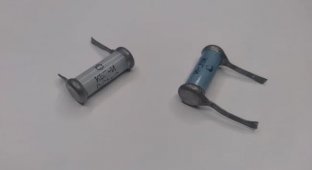Understanding the design of the Soviet resistor PEV-7.5 (4 photos)
Hello everyone. Friends, today I would like to discuss with you the design of the Soviet resistor PEV-7.5. The appearance of this resistor is shown in the figure below. 
A combat veteran PEV-7.5 from the 80s
The marking of this resistor is deciphered as follows: P - wire, E - enameled, V - moisture-resistant. The value 7.5 means the value of the nominal power for which this resistor is designed. In this case, the nominal value of this resistor is 390 Ohm, the deviation of the actual resistance value from the nominal value is no more than 5%. 
Removing unnecessary parts =)
The screw with nuts and plastic washers acts only as a fastening structure of this resistor inside the product and does not affect the parameters of this resistor. If there is no need for fastening, it can simply be removed. Unscrew the nuts on the sides of the resistor and remove the screw from the ceramic body of the resistor. 
The design of the PEV resistor
Structurally, this resistor is made in the form of a tubular base made of ceramics (high-strength ultraporcelain or talc-chamotte refractory ceramics), on which constantan wire (for low-resistance models) or nichrome wire (for high-resistance models) is wound. Please note that this wire is not insulated. 
I chipped off a piece of enamel from the top of the PEV resistor, the wire was exposed
This winding is covered with a glassy heat-resistant green enamel on top. It is very strong, when I was preparing this article I tried to scrape it off with a knife, but it didn't work. I managed to chip off a small piece with a few medium-force blows with a hammer, note that the ceramic base was not damaged in any way, but only a piece of paint chipped off from the top of the resistor. The resistor design itself is very powerful and very strong, it is very, very difficult to damage.
The ends of the wire, located under the varnish, are soldered to terminals made of brass. The terminals are tinned. These terminals are used to connect the resistor to the circuit of the device in which it will be used.
The rating of this resistor is determined by the material of the wire used, its cross-section and the number of its turns.

























